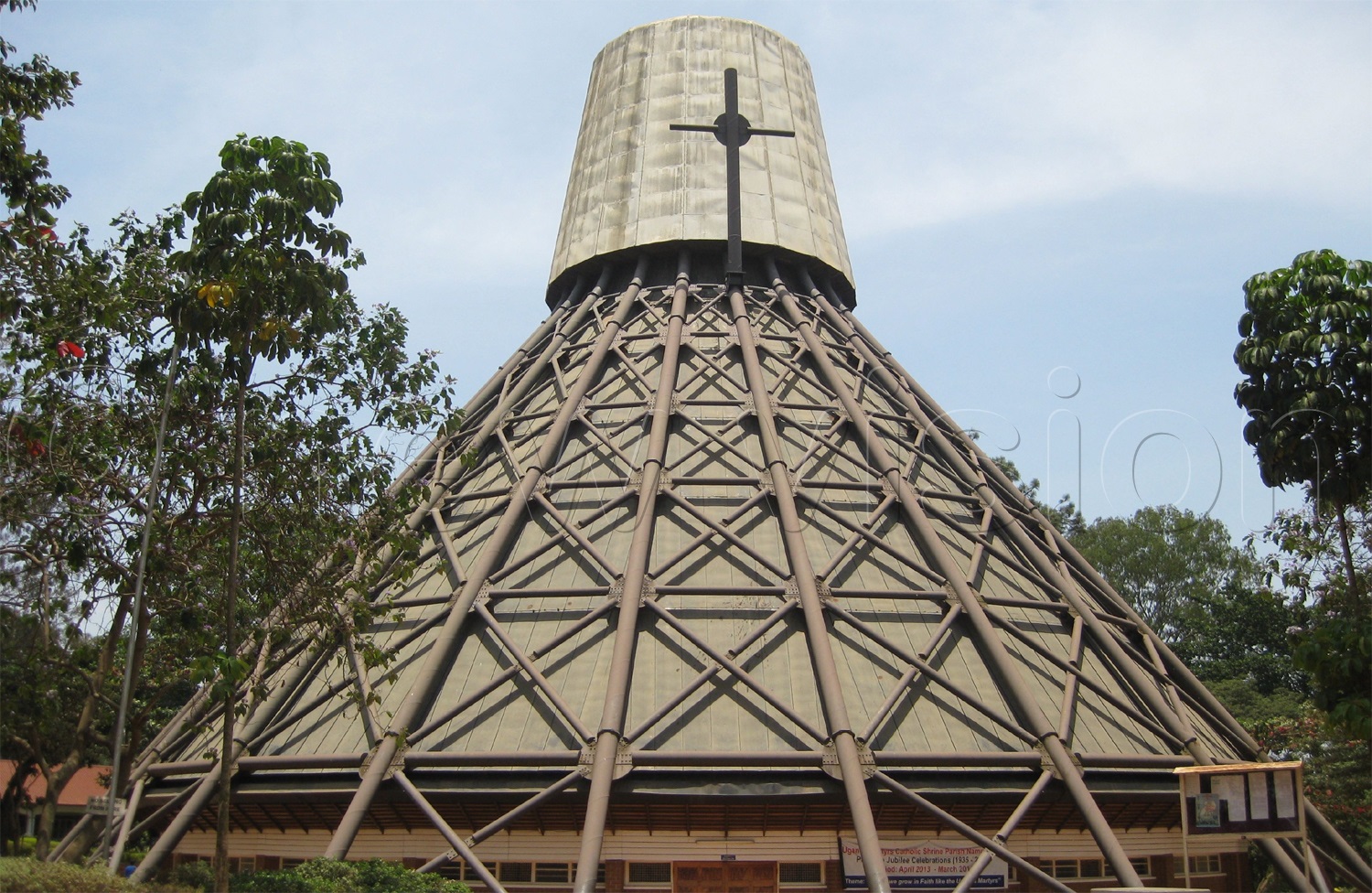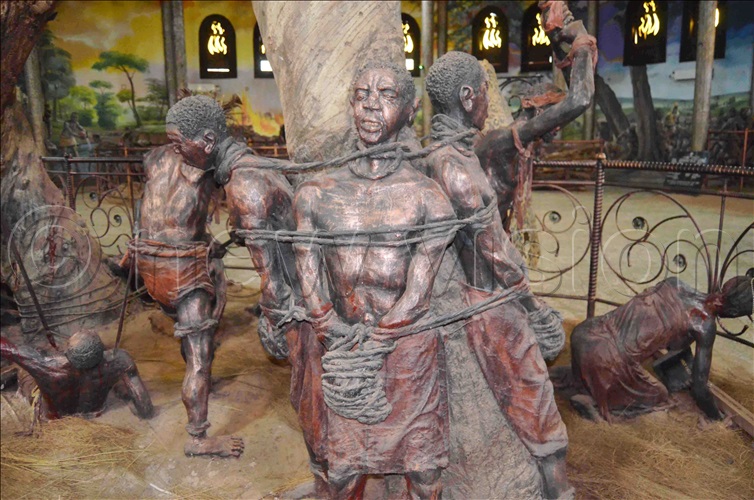Understanding why Namugongo is a crowd puller
May 31, 2022
Namugongo was an execution hub in the Buganda kingdom for groups of people deemed the worst criminals by the king

.
Hilary Bainemigisha
Editor @New Vision
Namugongo is located in Kyaliwajjala, Kira Municipality in Wakiso district, approximately 16 km from Kampala.
Every year on June 3, pilgrims from all over the world gather at Namugongo Martyrs' Shrine to commemorate the day, 3 June 1886, when 32 young palace pages were burned to death at the orders of Kabaka Mwanga for refusing to renounce Christianity.
There were 23 Anglican and 22 Catholic Christian martyrs who were executed between November 1885 and January 1887. 12 of the 22 Catholic Martyrs, were burnt to death at Namugongo, Kiyanja side of the Church of Uganda. Other Martyrs were hacked to pieces like Andrew Kaggwa, Pontian Ngondwe, Matthias Mulumba and Denis Ssebuggwawo. Others were speared to death like Gonzaga Gonza, while others like Charles Lwanga were speared to death at the place where the Namugongo shrine altar rests.

The 22 martyrs were beatified by Pope Benedict XV on 6th June 1920 and canonized by Pope Paul VI on 18th October 1964. They are regarded as saints in the Catholic Church.
History
Namugongo was an execution hub in the Buganda kingdom for groups of people deemed the worst criminals by the king. In his account of Faith in Uganda, Fr. Joseph Ddiba says the earlier known executions in Namugongo took place in 1877 when Mutesa I ordered the killing of 70 men for disobeying him. 8 years later, his son, Mwanga, threatened the believers to renounce their faith or be dispatched to their deaths in Namugongo. Mwanga wanted to raze everything Christianity stood for but, 131 years later, Christianity is still alive but the monarch is gone.
At the Catholic shrine, only Charles Lwanga, the leader of the Catholic martyrs was martyred. He was burnt to death in a slow fire under a Ggirikiti tree (Erythrina Abyssinica). He died on Thursday 3rd June 1886 (which was the Ascension day) at the age of about 25. The altar in the shrine was built on the spot where St. Charles Lwanga was burnt.
Birth of Namugongo shrine
According to the late Archbishop of Kampala, Dr Cyprian Kizito Lwanga, Namugongo Parish started as a sub-parish of Nsambya with its grass thatched church at Kyaliwajjala where Vienna Academy currently stands. Later in 1935, a young Dutch Mill-Hill priest, Fr. Stephen Walters, bought eight acres of land where the shrine now stands and started advocating for a parish at the spot where St. Charles Lwanga was killed. The first Parish Priest was Fr. Peter Van Rooyen and the late Msgr Lawrence Mbwega was the first Ugandan Parish Priest after the Mill Hill Fathers.

Later, in 1967, the late Emmanuel Cardinal Nsubuga, then Archbishop of the newly created Kampala archdiocese, decided to build a befitting martyrs’ monument at the site. According to one researcher, he was opposed by some sections of the church who considered it interference with the Mill Hill missionaries’ initiative. But Nsubuga’s will prevailed and his fundraising began in earnest.
Nsubuga’s zeal
According to Msgr Charles Kimbowa, one of the oldest priests in Kampala Archdiocese, the design was Nsubuga’s brainchild. Kimbowa, who was then a former private secretary of Nsubuga said the archbishop spared no sweat in fundraising locally and internationally.
Kimbowa recalled the Holy Saturday of March 26, 1967, when Nsubuga launched the fundraising at Lubaga Cathedral. He had a raffia bag (ekikapu) he had got from Naggalama Parish during his pastoral visit and that day, he collected sh8,857 (a lot of money then) for the start.
The next morning, Kimbowa said, Nsubuga, accompanied by Fr. Stephen Mukasa and Pere Y. Tourigny, left for Rome and the US. While in Rome, he got an audience with Pope Paul VI and presented his kikapu asking him to bless it. He explained its purpose and discussed the Uganda Martyrs project. Pope Paul VI contributed sh140,000 (a lot of money in 1969). Speechless Nsubuga, in appreciation, invited him to come and lay the foundation stone. When he accepted, to visit Uganda later that year, it was unbelievable for the pope to visit Africa considering the logistical problems, a health scare and unknown abilities in the African continent then. Thus Uganda became the first country to host the pope.
Construction
Dr Danhinden was the Architect of the Namugongo Martyrs Shrine. He designed it to look like an African hut, wrapped around 22 copper pillars signifying the 22 Martyrs and a white cap on top. The circular interior was to contain up to 1,000 seats.

Construction began in 1967 by Roko Construction Company. It was one of their first major project in Uganda. It was completed 8 years later and officially opened by His Eminence Cardinal Sergio Pignedoli on June 3, 1975. Thousands of pilgrims, including President Idi Amin, attended the ceremony.
18 years later, on February 7 1993, Pope John Paul II made a pilgrimage and officially declared it a minor Basilica, which Rome bestows upon certain churches following a major spiritual event.
The site
The shrine has been surrounded by a healthy green compound with thriving trees and an alleyway that leads to a man-made pond that once, according to historical accounts, served as a cleansing ground for executioners. Mbwenga, in his writing, said the lake used to be a little stream going through a swamp from where they used to grow yams, cabbages and sugarcane. It was Mbwenga, who developed the idea of opening up a place with a larger water basin. He started piling up mud in one place as he expanded the pond from which he grew fish. He wrote that he proposed to Nsubuga the idea of placing an altar on the mud in the 1950s from which pilgrims would see the priest as he conducted mass from all corners.
Nsubuga, who was going to host Pope Paul VI in 1969, loved the idea and brought graders to expand the water basin. Mud was piled in one place which was elevated to become the altar it is today.

Later, when Pope John Paul II came to Uganda in 1993, Cardinal Emmanuel Wamala asked the then chancellor of Kampala Archdiocese, Fr Kizito Lwanga, to expand and beautify the lake further, giving it a stone fence and more shelters for the pilgrims. Dr Kizito Lwanga later become the archbishop of Kampala and presided over its further beautification. But then, he constructed a round concrete plinth inside the pond to host the altar and on it, a grass thatched pavilion, also in circular form like the Shrine, was built to accommodate more than 300 people.
Many pilgrims have often drawn water from this lake and later given testimonies about its healing powers.
Visited by 3 Popes
On November 28, Pope Francis became the third pope to visit the shrine and says his pontificate mass there.
The first to visit was Pope Paul VI whose pontificate mass was on August 2, 1969. He consecrated the altar which was built at the spot where St. Kalooli-Lwanga was killed.
On February 7, 1993, Pope John Paul II said his Pontifical mass at Namugongo when he officially declared the shrine a minor Basilica.
Redevelopment
Lwanga continued the work he started as chancellor, to reconstruct the site in commemoration of its 50 years and also develop it into a modern user-friendly, international standard pilgrimage site.
According to Francis Mwonge, the shrine’s administrative secretary, the site which was worked on by Roko Construction Company, cost sh44b. The site now has 3 modern VIP pavilions, to enable Christians from all corners to see the main celebrant at the altar. There is a pilgrimage route, called the Martyrs Way, which snakes down the right of the mini-basilica, via Martyrs grottos, drawing a stone-paved ring around the amphitheatre, altar and the three pavilions
Other facilities are a new house for visiting clergy, a museum, dormitories, a gallery, and a 100 car parking lot.
The lake trough was reconstructed. Charles Byamugisha, the engineer in charge of the project, said the dirty water was drained to give the fresh spring water a free flow provision. A perimeter wall was constructed to restrain people from contaminating the water. A purifier was installed to clean the water for pilgrims who want to drink or carry it home through several collection taps.
Nsubuga-Balimwezo, another engineer at the site, said a concrete red marble altar was built, held by the four white and gold striped adjoining bridges in the forms of the cross over the pond water.
“The shrine grounds come together into one around green wonder with the Altar as an epicentre, bestrode with the 22-poles mini basilica,” Byamugisha said.

No Comment